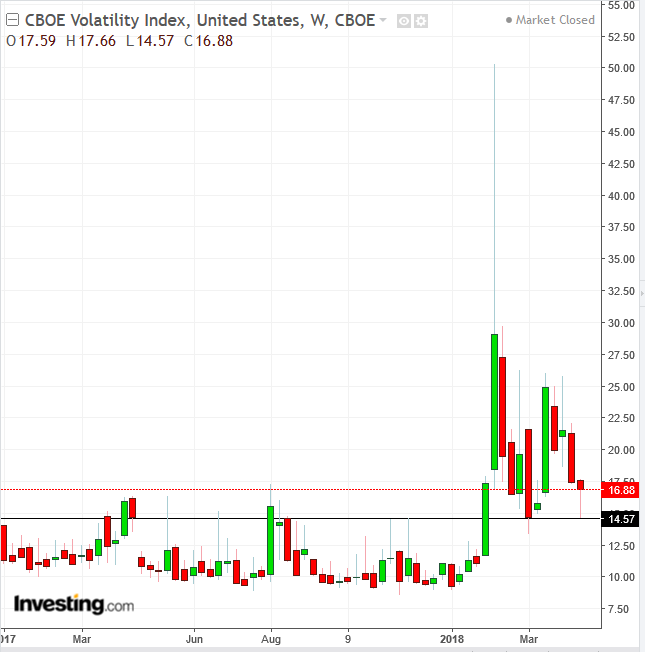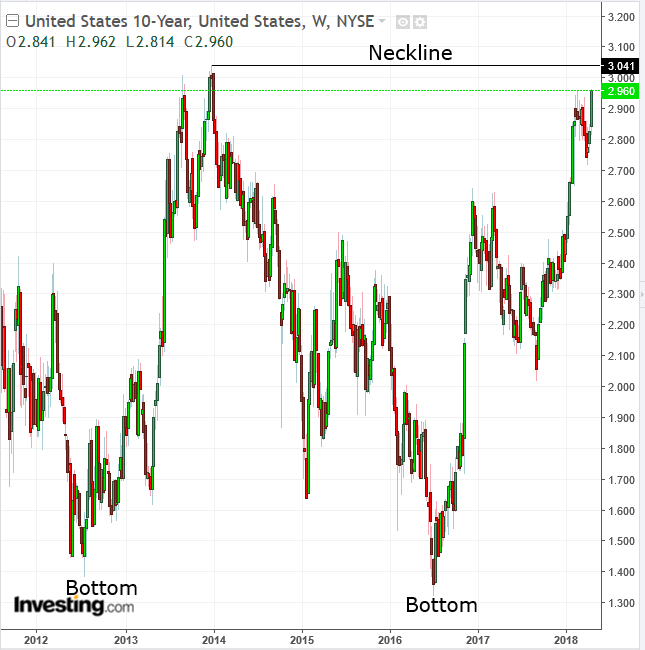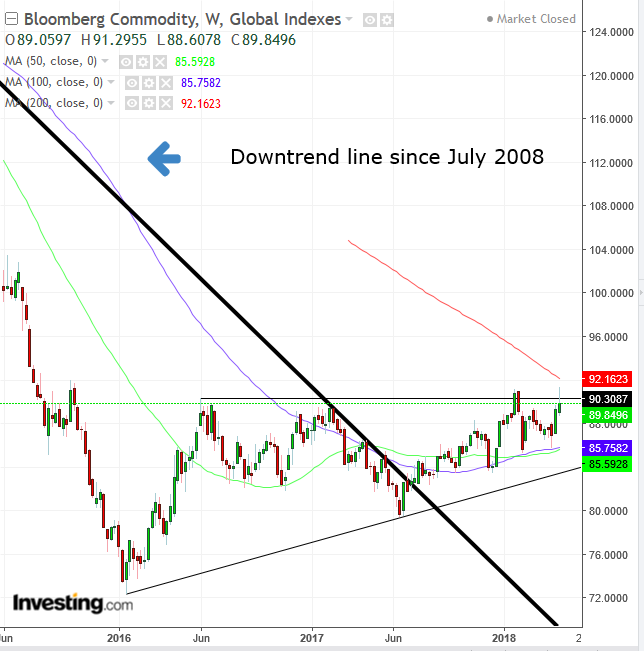- Earnings beat but stocks still trim weekly gains
- VIX this year higher than reading for almost all of 2017
- US yields hit 2.96 percent, reaffirming uptrend
- Why are both stocks and bonds selling off?
- Commodities, including oil, reach multi-year highs
- Dollar rises for four straight days
- Gold slips for two days straight
So far this earnings season, with most companies that have already reported hitting their sales targets and beating expectations, why did the promising US stock market rally—which boosted the S&P 500 2.3 percent by midday Wednesday—see the benchmark index finish out the week up a meager 0.52 percent? Even more perplexing, after having endured multiple political and geopolitical risks on hopes that earnings would save the day, why did investors sell off on Thursday and Friday when earnings have been everything they'd hoped for...and more?
Despite the escalating trade war between the US and China and ongoing tensions in the Middle East, the S&P 500 closed the week marginally higher. At the same time the Dow climbed 0.44 percent for the week, the NASDAQ added 0.55 percent and the Russell 2000 outperformed, jumping 0.98 percent for the week, its small-cap, largely domestic-focused companies benefiting by their distance from the tit-for-tat tariff skirmish.
Risk On..?
Consumer Staples (-3.99 percent), a defensive sector, was the week's laggard, while growth sectors pulled stocks higher. Energy (+2.65 percent) outperformed, followed by Industrials (+2.18 percent), Consumer Discretionary (+1.74 percent), Materials (+1.53 percent) and Financials (+1.53 percent). The growth sector responsible for most of last year's gains, Technology (-0.17 percent), was notably missing from the list of gainers, a result of newly levied tariffs.
Do these results mean investors are willing to take a risk, providing companies keep delivering?
...Or Risk-Off?

Over the past three days market volatility, as measured by the VIX, has been rising. Even Tuesday’s low of the week for the VIX, at 14.57—the support of the previous lowest closing price, on March 8—was still higher than during almost all of 2017. All this is occurring while companies have delivered on earnings.
But what happens if earnings turns sour and headline risk remains as is (or even escalates)? Stocks are barely holding on right now and volatility is accelerating.
Analyst predictions call for company growth of 15-to-20 percent this earnings season and results have been stellar thus far. Yet volatility is rising. Clearly, there's something unusual happening in markets.

During the same three days in which the VIX has been increasing and equities have been been falling from their highs during the week, the 10-year Treasury yield closed at 2.96, posting a new peak, higher than the February 21, intraday high of 2.597 with a 2.592 close. This new high reaffirms the uptrend since the July 2016 bottom.
It's the highest weekly close since December 2013. Should yields continue to gain past 3.041, it would complete a massive bottom since July 2012.
There is normally a negative correlation between stocks and bonds; put differently, there's a positive correlation between stocks and yields, as investors rotate capital from one asset class to another.
So why did both stocks and bonds sell off during the second half of the week?

Rising yields are also a result of expectations for higher inflation. Indeed, yields are rising globally, taking their cue from the US, the world’s largest economy.
Concurrently, commodities have been surging. Of course, rising prices also cause inflation. On Friday, the United States Commodity ETF (NYSE:USCI) reached its highest point since July 2015.
As well, technically, the Bloomberg Commodity Global Index has been forming an Ascending Channel, demonstrating that demand is eating up supply. Once that is fully absorbed, supply would have to bid up to find more supply, completing a bottom.
Still, tariffs and an accelerating trade war between the world’s two largest economies have taken their toll. Oil also reached a 3.5 year high, spurred by output cuts from Saudi Arabia and Russia, even while US production has been growing as fast as infrastructure would allow. As well, geopolitical risk from Syria—though not an oil producer—has investors concerned about the possibility of supply disruptions. Nevertheless, the other side of the equation shows global demand has been increasing.
Inflation Fears Climbing?
The question investors appear to be asking: if inflation does pick up, will the Fed raise interest rates significantly, in order to quell high inflation, which could bring on a recession?
Among the past week’s best performers were commodity related sectors (Energy, Industrials and Basic Materials) whose gains would eventually lead to higher interest rates as enumerated above, thereby increasing bank profits and lifting Financials as well. However, if rates do move higher more quickly than expected, would investors keep bidding up these sectors in a recession? Probably not.
Moreover, even with powerful earnings results, US stocks barely eked out a gain for the week. If earnings begin to disappoint, investors will have nothing left to hold onto. Thus, add together the confluence of risks and the growing potential for a recession with commodity prices on the rise, and it could well be that investors are in the process of deciding that even if companies continue to show they've outdone themselves as far as earnings are concerned, those numbers no longer reflect a rosy future because the global risk factors continue to darken the horizon.
If that's the case, the stock sell-off during the second half of the week could be early signs of that old Wall Street adage: “Buy on the rumor (the expectation of a strong earnings season), sell on the news (reports of strong results).”

Meanwhile, the dollar rose for four straight days this past week, within a Symmetrical Triangle since January. The pattern’s lack of decisiveness (not an ascending or descending triangle, in which bulls or bears have command) demonstrates doubt, which means that while there is some expectation of it breaking to the downside, within its downtrend, it could bottom out, as well.
Gold correlates negatively to the dollar. It too, is forming a doubt projection via a symmetrical triangle of its own. While rising rates will increase demand for the dollar, higher inflation increases demand for gold, as a hedge against eroding buying power.
We can’t, of course, be sure which theme will be dominant going forward, but we can be certain of volatility in the coming weeks and months.
Key Economic Events
All times listed are EDT
Sunday
22:30: Japan – Manufacturing PMI (April, flash): expected to fall to 52.6 from 53.2.
Monday
4:00 - 5:00 – French, German, Eurozone Services and Manufacturing PMIs (April, flash): these are expected to ease back slightly, and as a result could put EUR under additional pressure.
8:30: US – Chicago Fed National Activity Index (March): expected to fall to 0.2 from 0.88. The marginal rise in manufacturing production and paltry 103,000 nonfarm payrolls job addition offset solid building permits and mining and utility production.
9:45: US – Services and Manufacturing PMIs (April, flash): manufacturing to fall to 55 from 55.6, while services to hold at 54. After PMIs have been trending at healthy mid-50s rates, tariffs may reshuffle the deck, potentially affecting both price and inventory results, as well as appear in the report's comments.
10:00: US – Existing Home Sales (March): expected to decline to an annual rate of 5.528 million from 5.540 million. Supply on the market has been well below demand which has been lifting prices and holding down sales.
21:30: Australia – CPI (Q1): forecast to be 2% YoY and 0.7% QoQ, from 1.9% and 0.6%.
Tuesday
4:00: Germany – Ifo Index (April): business climate index to rise to 114.8 from 114.7.
10:00: US – Consumer Confidence (April), New Home Sales (March): confidence remains high, at 127.7, slightly dropping from 127.7 in March, receiving a boost from the tax overhaul; new home sales to rise 630,000 from February's 618,000. New homes sales have been struggling, after peaking late last year, pressured by rising mortgage rates and limited supply.
Wednesday
10:30: US – EIA Crude Inventories (w/e 20 April): stockpiles expected to rise by 290,000 barrels, from a drop to 1.07 million a week earlier.
Thursday
2:00: Germany – GfK Consumer Confidence (May): forecast to fall to 10.8 from 10.9.
7:45: Eurozone – ECB Rate Decision (1.30pm Press Conference): no change in rates expected. While there is a growing belief that the bank will have to tighten policy in due course, recent weaker economic data may well allow Mario Draghi to stick with the central bank's accommodative stance.
8:30: US – Durable Goods Orders (March): forecast to rise 1% MoM from 3.1%, and 0.4% MoM excluding transportation, from 1.2% a month earlier.
19:30: Japan – Unemployment Rate (March): forecast to rise to 2.6% from 2.5%.
23:00: Japan – BoJ Decision: no change expected here, but hints of a possible hawkish shift could be positive for JPY.
Friday
3:55: Germany – Unemployment Rate (April): expected to remain at 5.3%, while the unemployment change drops by 15K from a 19K drop in March.
4:30: UK – GDP (Q1, preliminary): growth is expected to be 0.4% QoQ and 1.5% YoY, from 0.4% and 1.4% respectively.
5:00: Eurozone – Business Confidence (April): forecast to rise to 1.39 from 1.34.
8:30: US – GDP (Q1, advanced reading): expected to be 2.3% QoQ, from 2.9%.
10:00: US – Michigan Consumer Sentiment (April, final): expected to be 98 from 101.4

